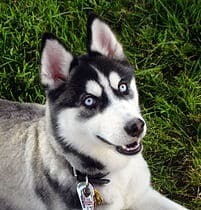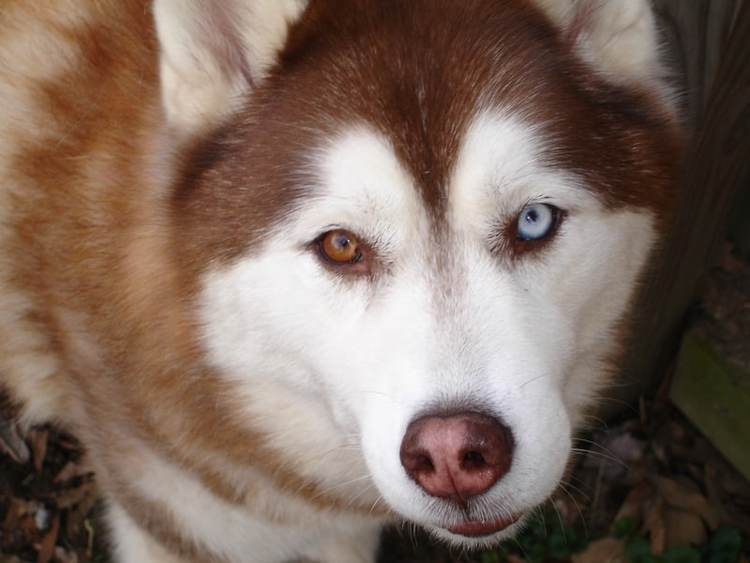A lot of people think huskies are either black, white or gray — while many of them do fall within this spectrum, husky colors and markings are in fact a lot more diverse, with huge differences to be spotted between individual dogs.
Some people call this the ‘Siberian Rainbow’!
Here we’ll take a look at some of the most common husky colors and husky markings, as well as some of the more unusual combinations you might not have have been aware of.
Most Common Husky Colors
The American Kennel Club (AKC) recognize these as standard husky colors:
- Agouti (banded color) and white
- Black and white
- Gray and white
- Red and white
- Sable and white
- White
Less formal organizations like the International Siberian Husky Club, however, recognize a wider range of colors for the breed.
Let’s take a look at some of the most popular husky colors:
Black and white

Black and white huskies are one of the more common appearing colors of the breed, although there can still be plenty of variation within just these shades.
Black hairs can be jet black, normal black or slightly lighter — more of a salt and pepper look.
These lighter black coats are referred to as ‘diluted’, while the coat can appear almost gray during shedding season. The undercoat of a black and white husky is likely to be a patchwork of shades between black and white.
White
Some argue that an all-white husky is actually the result of a particular coat pattern whereby the white hairs cover up any black, gray or red as the result of a recessive gene. The AKC do recognize it as a standard color, however.

The undercoat of this rarely colored husky is likely to be silver or white while the nose and skin around the eyes will be black or brown.
Sable
Sable huskies are typically of a reddish brown hue with a black nose and black tipping on the hairs. It’s common for sable huskies to become more red in hue as they age, likely born more of a darker gray. Their color can be diluted which may influence the shade too.
They’re commonly referred to as ‘black-nosed reds’ and their undercoat is also likely to be red, chocolate or copper — although never beige.

Agouti
Agouti-colored huskies always have a banded coat and are typically very similar aesthetically to wolves. Some people even call agouti ‘wild coloring’!
The face of an agouti husky is typically dominated by a dark mask, which extends down through much of the body. The white markings of an agouti husky edge on the cream side rather than white.
Nose, eyes and mouth are similarly dark while there is never any dilution in the coloring.
Red

There is a fascination with red huskies among dog lovers as they seem so different to the black and gray coloring that most people expect to see.
They generally have a white underbelly with liver colored noses, eyes and points, and the red color can be diluted from anything from light red, almost white, all the way down to an almost chocolate colored red.
Copper
Copper and white huskies aren’t recognized as standard by the AKC but they are nevertheless an incredible variation on the breed.
The difference between a copper husky and a red husky is that the copper ones are typically lighter and more inclined towards orange or yellow in color than red.
There are also chocolate copper huskies — also known as chocolate reds — who are richly brown with auburn undertones.
Saddleback
Saddleback is technically more of a marking than a specific husky color but they are included here for their distinction. The face and legs of a saddleback are traditionally white, possibly erring towards red, with black markings over the saddle area.
Gray
Gray and white huskies are one of the more commonly seen colors of the breed but there’s more to them than meets the eye.

There are three different types of husky gray:
- Wolf gray — the darker and more grizzly gray seen in agouti huskies. There’s often hints of red in the areas around the face and ears. [See our comparison: Wolf vs Husky]
- Gray — this is a medium to dark gray, very common and generally paired with a beige or yellow undercoat
- Silver gray — much lighter than the other grays with a seemingly blue undertone, paired with a white undercoat. Silver gray can be diluted to the extent that it can even look blue.
Black
Black huskies are again not recognised as standard by the AKC but that’s not to say that they don’t exist. These huskies are mostly black with some white markings down their chests, legs, around the nose and on their socks.
The undercoat is either black or at least dark gray with very dark paw pads too.
Husky Eye Colors
Many people assume that all huskies have piercing blue eyes, but there’s actually much more variation than that.

Husky eyes can be…
- Blue
- Brown
- Amber: particularly common in red, red and white, and white huskies
- Bi-eyed: different colored eyes
- Parti- or split-eyed: each eye includes a mix of two colors — due the iris splitting.
See more: 21 adorable photos of mini huskies.
Husky Markings
According to the AKC, there are three standard types of husky markings:
- Piebald –– where the husky is more than 30% white with other unique markings
- Pinto –– pinto huskies usually sport lots of white towards the front of its body, especially on the legs and shoulders
- Black points –– this refers to the dark pigmentation on the skin around the eyes, on the paw pads and on the nose
Not specified by the AKC but commonly referred to amongst husky owners, splash is also a type of husky marking — usually where the saddle is a different color to the rest of the body. This could be interchangeable with the saddleback color discussed earlier.


Wanted to learned ,,how to take care the little babies husky….n teach them well..any tips for special training..thanks..
Out of curiosity what type of husky would you call mine. He is around 50 pounds. Piercing blue eyes, he is 3 years old. His coat is short yet he sheads almost like as if he is melting!!! ” I brush him daily with a good desheading brush. However his face is all white but he does have black and grayish on his head. His nose is pink and black…Underneath he is mainly white but the top part of his body is black, with some white underneath the black.
I really don’t know what kind of husky mine is An lol it’s really boggling my mind
Are Alusky dogs common?